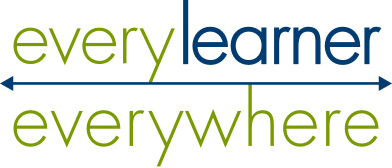Every Learner Everywhere will always be on the side of innovation in the name of improving teaching and learning and accessibility. That’s why we have a strong commitment to explore — not ignore — artificial intelligence.
In our new formal statement on our approach to AI (see sidebar), developed with input from our network partners, we embrace the examination of AI to help instructors and students understand what it can do and how it can assist them in achieving academic goals.
To do otherwise would be to ignore the possibilities that AI presents for supporting education, for improving student outcomes for every learner, and for making learning more ADA accessible. It also would disregard the message that Every Learner has heard loud and clear from students: AI is now part of the academic and workplace experience.
Embracing AI use
AI is emerging as a technological force as institutions are still grappling with the aftermath of the COVID-19 pandemic. Some colleges and universities, understandably wary of yet another potential disruption to higher education, chose to downplay or ban AI. It seemed wise to determine whether AI was here to stay before devoting resources to examine how best to use this innovation at their institutions.
Students, meanwhile, increasingly turned to AI tools as part of the educational process, even as they found that they also had questions about AI and its future.
Now a growing number of our network partners believe that the time to wait and see what will happen with AI is over. Institutions increasingly understand that we owe it to students to uncover AI’s potential and pitfalls today. Finding the most effective and ethical uses for AI tools now can improve learning and accessibility for years to come.
Identifying student success challenges
Concerns certainly exist regarding AI’s impact on student success, with lack of accessibility and the risks of algorithmic bias at the forefront of issues to consider. Institutions are grappling with questions such as:
- What happens when students ask questions of an AI tool trained on content that’s not inclusive?
- How do we ensure that everyone can take advantage of AI’s capabilities, regardless of students’ ability to access and pay for the tools?
- Will AI disrupt the interpersonal relationships that are so critical to student support?
But academia has a long history of encountering technological innovations that it feared could interfere with its ability to educate students. Decades ago, for example, instructors wondered whether the calculator’s quick computations would stand in the way of effective math instruction. When the internet became broadly accessible through web browsers, educators worried that its plethora of answers would hamper students’ ability to think through questions and find their own solutions.
As instructors and their students explored the various uses for these tools, however, they discovered they can offer benefits ranging from streamlining administrative tasks to assisting with student research.
They learned that with proper guidelines and practices, these resources can enhance instruction for all students. Now we cannot imagine life without them.
We believe AI holds this same promise. We embrace AI because, just as it can create challenges, it also offers opportunities to overcome them.
And there’s only one way to uncover the problems and solutions associated with AI: exploration.
Promoting responsible use
Every Learner partners with institutions, organizations, and students to conduct this exploration. Through our network, we work to provide guidance and answer questions about AI, with the goal of improving instructional processes and student achievement.
We’re learning from partners and students the importance of creating a plan to address potential problems with AI, such as designing prompts that help avoid the biases that can be apparent in information and images that AI produces. We’re discovering AI tools that help ensure students of all abilities have equitable access to content they must understand to succeed in school.
And we’re finding ways AI can streamline processes for instructors and students, freeing them up for other activities — such as in-depth study or instructional support — that are vital to academic success. Our network partners are leading the way in these efforts. For example, a forthcoming report from Teach Access and Every Learner Everywhere, Where AI Meets Accessibility: Considerations for Higher Education, examines the benefits and concerns of AI in accessibility instruction.
We also are learning that it’s not just institutions that find themselves searching for support in developing literacy in AI and using its tools in their instruction. Students are helping us find the answers to questions about AI, through online presentations and internship projects in which students delve into their own experiences and conduct research on AI’s capabilities for advancing student success.
Innovating teaching and learning
The goal of this work is to harness AI’s power to promote improved outcomes in learning through broader access to and engagement in learning experiences. Every Learner Everywhere will continue to embrace the exploration of the benefits and challenges of AI and its use in instruction. Our mission in support of using technology to innovate teaching and learning and level the education playing field demands no less.


